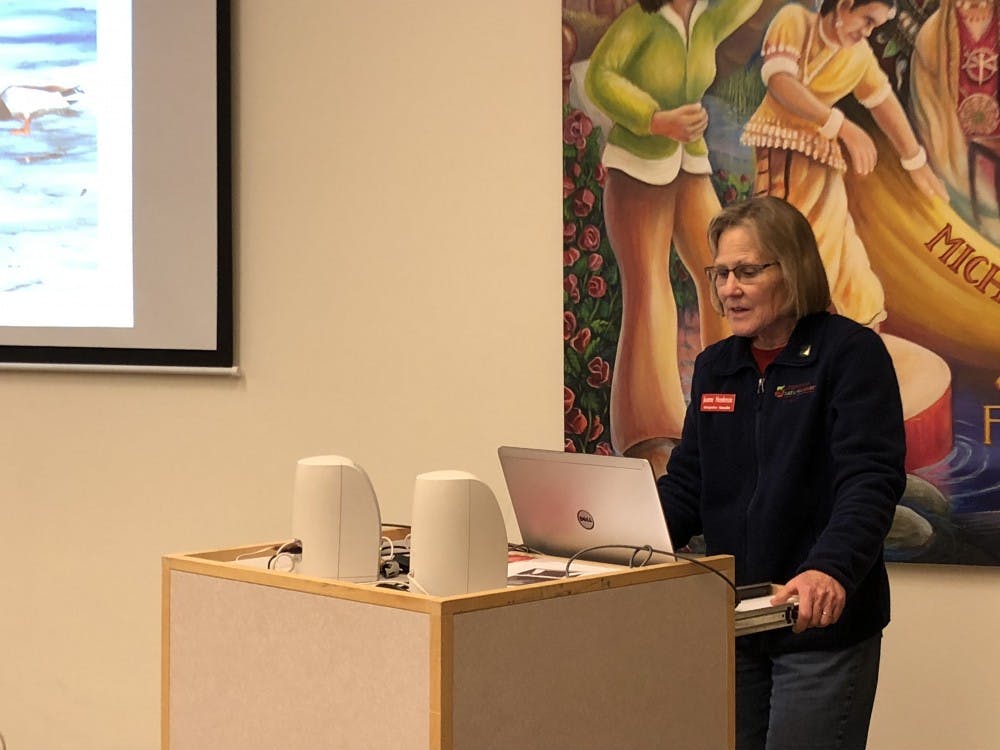Naturalist shares how birds use adaptations to survive harsh Michigan winters

Naturalist Jeanne Henderson speaks about how birds survive Michigan winters on Nov. 28 in the Veterans Memorial Library located at 301 S. University Ave. in Mount Pleasant.
Chippewa Nature Center naturalist Jeanne Henderson discussed physical and behavioral adaptations birds have that allow them to survive harsh Michigan winters.
She spoke on Wednesday at the Veterans Memorial Library as a part of a guest speaker series for the Chippewa Watershed Conservancy.
Henderson said about two-thirds of birds will fly south for the winter, but the remaining third will shelter in Michigan. These birds include chickadees, evening grosbeaks, pine siskins, and American goldfinches.
She said these birds must be able to find food, water, shelter and a living space to remain in the North. The birds will eat seeds or dried berries produced by plants in the summer, drink water from streams or water people provide, and take shelter in areas like brush piles and tall evergreens.
However, Henderson said these birds must stay warm during the winter, and many cannot afford to gain a lot of extra weight because it would inhibit their flight ability. The birds will gain minimal amounts of weight, such as two to three grams and, instead, grow more down feathers.
“The fluffy barbs on the down feathers can trap warm air that leaves the bird’s body, keeping their skin a lot warmer,” said Henderson. “It’s almost like them wearing a shirt.”
Birds will also shiver to stay warm, said Henderson. However, humans do not see the birds shivering because they do it internally.
She said birds also have behavioral adaptations that help them survive the cold. One example is birds will flock together when they take shelter for the night.
“It’s kind of like having a slumber party for birds,” said Henderson. “They’ll gather together, and if four or more birds can huddle together, they’ll share their body heat.”
Birds will also tend to eat more seeds during the winter, said Henderson, because seeds have more fats, which give them more energy to store.
Community member Marilyn Western said she has had bird feeders out in her yard for years and always watched the birds. She thought it was fascinating to find out their physiological adaptations and behavioral tactics.
“I see all these birds all the time and it makes (me) wonder, especially when it gets really cold towards night… ‘how do they handle this?’” said Western.
Henderson shared ways humans can provide refuge for the creatures.
One way is putting sunflower seeds and suet in bird feeders. Providing thistle feeders towards the end of the winter can also be beneficial.
Community member Sharon Wisniewski found it helpful to learn what the birds in Mount Pleasant prefer to eat because she was new to the area.
Henderson said people must clean bird feeders at least once a month to prevent the spread of disease among birds. They should also rake beneath feeders to remove old, moldy seeds and bird droppings.
She said other ways people can assist birds is to put out trays of water or purchase a heated bird bath, because finding water in the winter can be difficult. Also, people can use old Christmas trees or other dead branches to create a brush pile that birds can roost in for the night.



